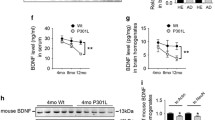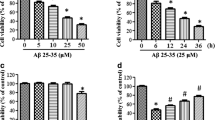Summary
The human brain-derived neurotrophic factor (hBDNF) gene was cloned by polymerase chain reaction and the recombinant adeno-associated viral vector inserted with hBDNF gene (AAV-hBDNF) was constructed. Cultured rat hippocampal neurons were treated with Aβ25–35 and serued as the experimental Aβ-induced neuronal damage model (AD model), and the AD model was infected with AAV-hBDNF to explore neuroprotective effects of expression of BDNF. Cell viability was assayed by MTT. The expression of bcl-2 anti-apoptosis protein was detected by immunocytochemical staining. The change of intracellular free Ca ion ([Ca2+]i) was measured by laser scanning confocal microscopy. The results showed that BDNF had protective effects against A-induced neuronal damage. The expression of the bcl-2 anti-apoptosis protein was raised significantly and the balance of [Ca2+]i was maintained in the AAv-hBDNF treatment group as compared with AD model group. These data suggested that recombinant AAV mediated a stable expression of hBDNF in cultured hippocampal neurons and resulted in significant neuron protective effects in AD model. The BDNF may reduce neuron apoptosis through increasing the expression of the bcl-2 anti-apoptosis protein and inhibiting intracellular calcium overload. The viral vector-mediated gene expression of BDNF may pave the way of a novel therapeutic strategy for the treatment of neurodegenerative diseases such as Alzheimer’s disease.
Similar content being viewed by others
References
Yamada K, Mizuno M, Nabeshima T. Role for brain-derived neurotrophic factor in learning and memory. Life Sci, 2002, 70(7):735–744
Lowenstein D H, Arsenault L. The effects of growth factors on the survival and differentiation of cultured dentate gyrus neurons. J Neurosci, 1996,16(5):1759–1769
Holsinger R M, Schnarr J, Henry P et al. Quantitation of BDNF mRNA in human parietal cortex by competitive reverse transcription-polymerase chain reaction: decreased levels in Alzheimer’s disease. Brain Res Mol Brain Res, 2000,76(2):347–354
Schabitz W R, Schwab S, Spranger M et al. Intraventricular brain-derived neurotrophic factor reduces infarct size after focal cerebral ischemia in rats. J Cereb Blood Flow Metab, 1997,17(5):500–506
Egleton R D, Davis T P. Bioavailability and transport of peptides and peptide drugs into the brain. Peptides, 1997,18(9):1431–1439
Klein R L, Meyer E M, Peel A L et al. Neuron-specific transduction in the rat septohippocampal or nigrostriatal pathway by recombinant adeno-associated virus vectors. Exp Neurol, 1998,150(2):183–194
Ma D L, Ren H M, Hu H T et al. Molecular cloning and sequencing of human BDNF gene encoding mature peptide. Chin J Neuroanat (Chinese), 2002,18(1):75–78
Ma D L, Hu H T, Wang J M et al. Preparation of the huma brain-derived neurotrophic factor recombinant adeno-associated virus. J Xi’an Jiaotong Univ (Med Sci) (Chinese), 2003,24(5):431–433
Du X C, Ren H M, Hu H I et al. Gene therapy vector based on adeno-associated virus type-2. Acad J Xi’an Jiaotong Univ (Med Sci) (Chinese), 2001, 22(1):100–104
Brewer G J. Isolation and culture of adult rat hippocampal neurons. J Neurosci Methods, 1997,71(2):143–155
Mosmann T. Rapid colorimetric assay for cellular growth and survival: application to proliferation and cytotoxicity assays. J Immunol Methods, 1983,65(1–2):55–63
Qian Y H, Ren H M, Hu H T et al. Effect of the total saponin of dipsacus asper on intracellular free calcium concentration in the cellular model of Alzheimer’s disease-scanning confocal microscopy. Acad J Xi’an Jiaotong Univ (English), 2001,13(2):159–163
Ma D L, Liu Z H, Hu H T et al. Expression of the human BDNF by recombinant adeno-associated virus in the primary cultured rat hippocampal neurons. Acad J Xi’an Jiaotong Univ (English), 2003,15(S):63–65
Ferreiro E, Oliveira C R, Pereira C. Involvement of endoplasmic reticulum Ca2+ release through ryanodine and inositol 1,4,5-triphosphate receptors in the nearotoxic effects induced by the amyloid-beta peptide. J Neurosci Res, 2004,76(6):872–880
Suen K C, Lin K F, Elyaman W et al. Reduction of calcium release from the endoplasmic reticulum could only provide partial neuroprotection against beta-amyloid peptide toxicit. J Neurochem, 2003,87(6):1413–1426
Author information
Authors and Affiliations
Corresponding author
Additional information
LIU Zhaohui, male, born in 1971, M.D., Ph.D
This project was supported by a grant from Natural Sciences Foundation of Shaanxi Province, China (2003K10-G83-2).
Rights and permissions
About this article
Cite this article
Liu, Z., Ma, D., Feng, G. et al. Recombinant AAV-mediated expression of human BDNF protects neurons against cell apoptosis in Aβ-induced neuronal damage model. J. Huazhong Univ. Sc. Technol. 27, 233–236 (2007). https://doi.org/10.1007/s11596-007-0304-x
Received:
Issue Date:
DOI: https://doi.org/10.1007/s11596-007-0304-x




